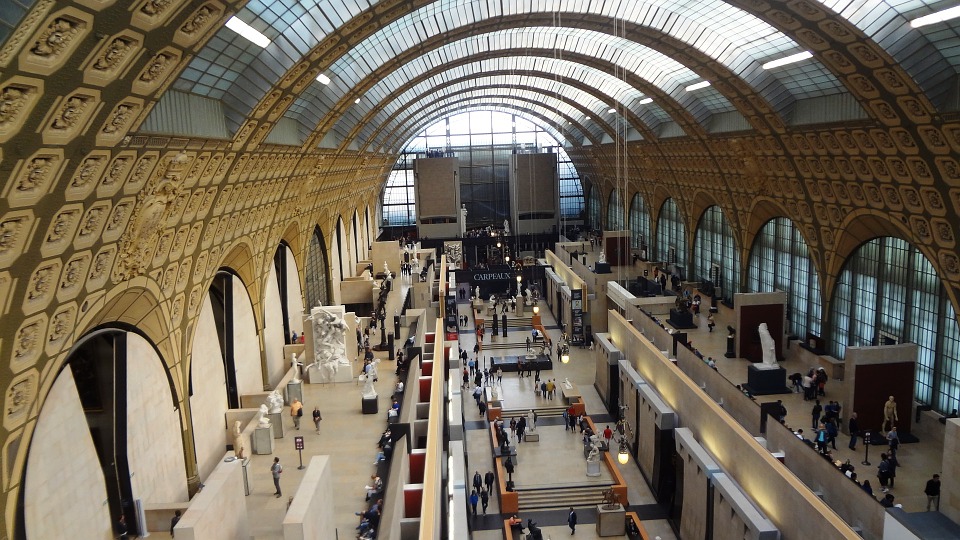A Trip to Paris: Visiting the French Capital’s Most Famous Attractions (Part 10) Posted by mtaulier on Dec 18, 2013 in Culture
As we near the end of our journey through the city of Paris, I’d like to return to some of the older tourist attractions that you might not be familiar with. We discovered elements of the more modern side of Paris in the last few posts but today we’ll be going back in time to visit the famous Musée d’Orsay (Orsay Museum).

Located across the Seine River from le Jardin des Tuileries (the Tuileries Gardens) and the Louvre, the Musée d’Orsay was originally the site of the Palais d’Orsay (Orsay Palace) that lay in ruins after un incendie (a fire) ravaged the surrounding neighborhood in 1871. A contest was held in 1898 to transform the ruins of the Palais d’Orsay into a magnificent railway station that became the Gare d’Orsay (Orsay Station). Architect Victor Laloux won the honor and work was completed just in time for the World Fair held in Paris on July 14th, 1900. Combining elements of late 18th and early 19th century architecture, the museum blends in beautifully with the surrounding buildings. Le plafond de verre (glass ceiling), reminiscent of its days as a railway station, lets in a generous amount of light that only serves to enhance the experience. The building was classified as a Historic Monument in 1978. In December of 1986, the museum was inaugurated by French president François Mitterrand and its doors were opened to the public a few days later.
Unlike the Louvre, the Musée d’Orsay is exclusively dedicated to la peinture et la sculpture (paintings and sculpture) along with photography and graphic arts exhibits. Though not as popular as the Louvre, over three million people visit the Musée d’Orsay every year. The museum houses some of the best examples of western art created between 1848 and 1914 and covers a wide range of artistic periods including Neoclassicism, Romanticism, Realism, Impressionism, Symbolism and much more. The museum is divided into trois niveaux (three levels) with its own galleries. If you particularly admire artists from the Impressionist and Post-Impressionist period, the Musée d’Orsay will certainly please you. If the experience of being face-to-face with Da Vinci’s Mona Lisa at the Louvre was compelling, you will be happy to know that you can look upon original works by Vincent van Gogh, Edgar Degas, Claude Monet, James Whistler, Georges Seurat, Paul Gauguin, Camille Pissaro, Edouard Manet, Auguste Renoir, Auguste Rodin and many others at le Musée d’Orsay.
The Musée d’Orsay offers un régal pour les yeux (a feast for the eyes) and, like the Louvre, should be consumed slowly in order to appreciate the intricacies and details of many of the world’s most prized works of art. I would not suggest trying to take in both the Louvre and the Musée d’Orsay on the same day. Both are definitely worth a thorough visit and should be seen on separate days if you have the opportunity to do so.
Hours are from 9:30 am to 6 pm Tuesday through Sunday sauf le Jeudi (except for Thursday) when the museum closes at 9:45 pm. Tickets are 9€ with guided tours and audioguides made available (audioguides are an extra 5€ and are available in French, English and Italian). Il est interdit de prendre des photos (it is forbidden to take pictures) or to film anything within the museum, so keep that in mind.
If you are dragged against your will to the Musée d’Orsay by your spouse or by a family member, there is no need to fret. The museum offers a bookshop/giftshop, two cafés and a restaurant, all of which provide a relaxed setting you can use to catch up on some reading, send some e-mails to family back home or get some work done. But I highly recommend taking a tour of the museum even if you do not appreciate fine art. You might never again have a chance to witness such artistic virtuosity first-hand. If one day you see prints of these original works, you will be able to say truthfully that you saw the real thing. If anything, it makes for good conversation.

Build vocabulary, practice pronunciation, and more with Transparent Language Online. Available anytime, anywhere, on any device.




Comments:
Reyhan Chaudhuri:
What an interesting way to entice and acquaint first-time visitors to the delights of Musee d’Orsay!